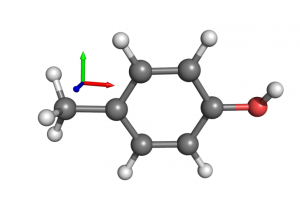Difference between revisions of "Axes"
Jump to navigation
Jump to search
(Axes which always stay in the lower left corner) |
|||
| Line 127: | Line 127: | ||
[[Category:Script_Library|Axes]] | [[Category:Script_Library|Axes]] | ||
[[Category:Math_Scripts|Axes]] | [[Category:Math_Scripts|Axes]] | ||
| + | [[Category:CGO]] | ||
Revision as of 08:55, 25 October 2012
Axes with text labels
# axes.py
from pymol.cgo import *
from pymol import cmd
from pymol.vfont import plain
# create the axes object, draw axes with cylinders coloured red, green,
#blue for X, Y and Z
obj = [
CYLINDER, 0., 0., 0., 10., 0., 0., 0.2, 1.0, 1.0, 1.0, 1.0, 0.0, 0.,
CYLINDER, 0., 0., 0., 0., 10., 0., 0.2, 1.0, 1.0, 1.0, 0., 1.0, 0.,
CYLINDER, 0., 0., 0., 0., 0., 10., 0.2, 1.0, 1.0, 1.0, 0., 0.0, 1.0,
]
# add labels to axes object (requires pymol version 0.8 or greater, I
# believe
cyl_text(obj,plain,[-5.,-5.,-1],'Origin',0.20,axes=[[3,0,0],[0,3,0],[0,0,3]])
cyl_text(obj,plain,[10.,0.,0.],'X',0.20,axes=[[3,0,0],[0,3,0],[0,0,3]])
cyl_text(obj,plain,[0.,10.,0.],'Y',0.20,axes=[[3,0,0],[0,3,0],[0,0,3]])
cyl_text(obj,plain,[0.,0.,10.],'Z',0.20,axes=[[3,0,0],[0,3,0],[0,0,3]])
# then we load it into PyMOL
cmd.load_cgo(obj,'axes')
Axes with nice cones
This script draws a simple cartesian coordinate system.
from pymol.cgo import *
from pymol import cmd
w = 0.06 # cylinder width
l = 0.75 # cylinder length
h = 0.25 # cone hight
d = w * 1.618 # cone base diameter
obj = [CYLINDER, 0.0, 0.0, 0.0, l, 0.0, 0.0, w, 1.0, 0.0, 0.0, 1.0, 0.0, 0.0,
CYLINDER, 0.0, 0.0, 0.0, 0.0, l, 0.0, w, 0.0, 1.0, 0.0, 0.0, 1.0, 0.0,
CYLINDER, 0.0, 0.0, 0.0, 0.0, 0.0, l, w, 0.0, 0.0, 1.0, 0.0, 0.0, 1.0,
CONE, l, 0.0, 0.0, h+l, 0.0, 0.0, d, 0.0, 1.0, 0.0, 0.0, 1.0, 0.0, 0.0, 1.0, 1.0,
CONE, 0.0, l, 0.0, 0.0, h+l, 0.0, d, 0.0, 0.0, 1.0, 0.0, 0.0, 1.0, 0.0, 1.0, 1.0,
CONE, 0.0, 0.0, l, 0.0, 0.0, h+l, d, 0.0, 0.0, 0.0, 1.0, 0.0, 0.0, 1.0, 1.0, 1.0]
cmd.load_cgo(obj, 'axes')
Axes which always stay in the lower left corner
from pymol import cmd
from chempy import cpv
class PutCenterCallback(object):
prev_v = None
def __init__(self, name, corner=0):
self.name = name
self.corner = corner
self.cb_name = cmd.get_unused_name('_cb')
def load(self):
cmd.load_callback(self, self.cb_name)
def __call__(self):
if self.name not in cmd.get_names('objects'):
cmd.delete(self.cb_name)
return
v = cmd.get_view()
if v == self.prev_v:
return
self.prev_v = v
t = v[12:15]
if self.corner:
vp = cmd.get_viewport()
R_mc = [v[0:3], v[3:6], v[6:9]]
off_c = [0.15 * v[11] * vp[0] / vp[1], 0.15 * v[11], 0.0]
if self.corner in [2,3]:
off_c[0] *= -1
if self.corner in [3,4]:
off_c[1] *= -1
off_m = cpv.transform(R_mc, off_c)
t = cpv.add(t, off_m)
z = -v[11] / 30.0
m = [z, 0, 0, t[0] / z, 0, z, 0, t[1] / z, 0, 0, z, t[2] / z, 0, 0, 0, 1]
cmd.set_object_ttt(self.name, m, homogenous=1)
def axes(name='axes'):
'''
DESCRIPTION
Puts coordinate axes to the lower left corner of the viewport.
'''
from pymol import cgo
cmd.set('auto_zoom', 0)
w = 0.06 # cylinder width
l = 0.75 # cylinder length
h = 0.25 # cone hight
d = w * 1.618 # cone base diameter
obj = [cgo.CYLINDER, 0.0, 0.0, 0.0, l, 0.0, 0.0, w, 1.0, 0.0, 0.0, 1.0, 0.0, 0.0,
cgo.CYLINDER, 0.0, 0.0, 0.0, 0.0, l, 0.0, w, 0.0, 1.0, 0.0, 0.0, 1.0, 0.0,
cgo.CYLINDER, 0.0, 0.0, 0.0, 0.0, 0.0, l, w, 0.0, 0.0, 1.0, 0.0, 0.0, 1.0,
cgo.CONE, l, 0.0, 0.0, h+l, 0.0, 0.0, d, 0.0, 1.0, 0.0, 0.0, 1.0, 0.0, 0.0, 1.0, 1.0,
cgo.CONE, 0.0, l, 0.0, 0.0, h+l, 0.0, d, 0.0, 0.0, 1.0, 0.0, 0.0, 1.0, 0.0, 1.0, 1.0,
cgo.CONE, 0.0, 0.0, l, 0.0, 0.0, h+l, d, 0.0, 0.0, 0.0, 1.0, 0.0, 0.0, 1.0, 1.0, 1.0]
PutCenterCallback(name, 1).load()
cmd.load_cgo(obj, name)
cmd.extend('axes', axes)
